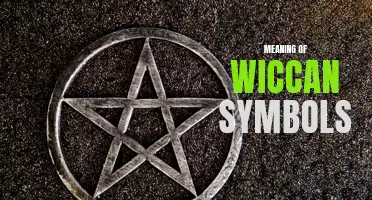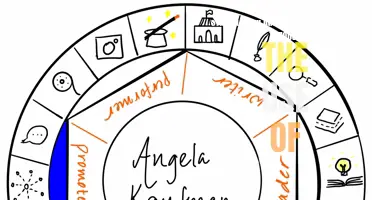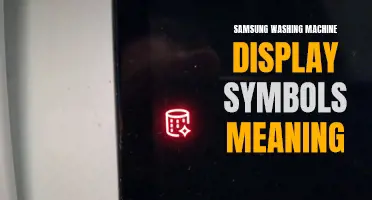
Have you ever noticed the blue ribbons worn by individuals or displayed in various places? These seemingly simple ribbons hold a deep and meaningful symbol. From representing awareness for various causes to honoring achievements, the blue ribbon has become a powerful and versatile emblem that has found its way into different aspects of our lives. In this article, we will explore the rich and diverse blue ribbon symbol meaning, and how it has become a significant part of our society.
What You'll Learn
- What is the history and origin of the blue ribbon symbol?
- What does the blue ribbon symbol generally represent or signify?
- Are there different variations or interpretations of the blue ribbon symbol depending on the context?
- Can you provide examples of situations or causes where the blue ribbon symbol has been used?
- How can individuals get involved or show support for causes represented by the blue ribbon symbol?

What is the history and origin of the blue ribbon symbol?
The blue ribbon symbol has a rich history and a significant origin that dates back to the early 19th century. Originally, the blue ribbon was used to represent excellence and achievement, particularly in the field of horsemanship. Over time, it has become a symbol of support for various social causes and awareness campaigns.
The origins of the blue ribbon symbol can be traced back to a tradition that started in England. In the 1800s, horse racing was a popular sport, and winners would often be awarded a blue ribbon as a prize. The blue ribbon came to symbolize victory, skill, and excellence in equestrian events. As a result, wearing a blue ribbon became a way for people to show their admiration for accomplished riders.
In the late 19th and early 20th centuries, the blue ribbon symbol started to gain prominence in social movements and awareness campaigns. One notable example is the temperance movement, which advocated for the reduction or elimination of alcohol consumption. The movement used a blue ribbon as a symbol of abstinence, encouraging individuals to pledge to never drink alcohol. This association with social change and public health issues helped to solidify the blue ribbon as a symbol of advocacy and awareness.
In the modern era, the blue ribbon has been used to bring attention to a wide range of causes. It has been associated with mental health awareness, child abuse prevention, and various forms of cancer awareness. For example, the blue ribbon is often used as a symbol for prostate cancer awareness, while light blue ribbons are associated with chronic fatigue syndrome and fibromyalgia awareness.
The blue ribbon's versatility and its ability to be adapted for different causes have made it a popular symbol for raising awareness and showing support. Its history as a symbol of achievement and excellence adds an additional layer of significance to its use in advocacy campaigns. Whether worn on clothing, displayed as a pin, or used in social media campaigns, the blue ribbon continues to be a powerful symbol for promoting social change and raising awareness for important issues.
Decoding the Mystery: What do the iPhone Charging Symbols Really Mean?
You may want to see also

What does the blue ribbon symbol generally represent or signify?
The blue ribbon is a symbol that is widely recognized and signifies various meanings depending on the context. It can represent awareness for a particular cause or disease, honor and support for a specific group or event, or symbolize victory and achievement.
One of the most well-known meanings of the blue ribbon is its association with awareness campaigns. Different colored ribbons have been used since the 1980s to raise awareness for various diseases and causes. The blue ribbon is commonly used to advocate for autism awareness, a developmental disorder that affects social interaction and communication in individuals. Autism awareness campaigns strive to promote understanding and acceptance of people with autism spectrum disorder (ASD) and to support research initiatives for better treatment and support systems.
In addition to autism awareness, the blue ribbon is also used to represent awareness for other causes such as child abuse prevention, colon cancer, bullying prevention, and human trafficking. Each cause has its unique blue ribbon design, often with a logo or symbol specific to the cause.
The blue ribbon is also used to honor and support various groups or events. For instance, in some countries, a blue ribbon may be worn on Mother's Day or Father's Day to show appreciation and celebrate parenthood. It can also be worn to honor law enforcement officers and show support for the police force. A blue ribbon can be tied around a tree or worn as a badge during Police Week to commemorate the sacrifices made by police officers.
Furthermore, the blue ribbon is associated with victory and achievement in different fields. In many competitions, such as county fairs or sporting events, a blue ribbon is awarded to the winner as a symbol of excellence. The blue ribbon signifies the highest level of accomplishment and distinguishes the winner from the rest of the participants.
Overall, the blue ribbon symbolizes a multitude of meanings depending on the context. It is often used to raise awareness for various causes, honor and support specific groups or events, or represent victory and achievement. The blue ribbon serves as a powerful symbol that brings attention to important issues and conveys messages of support and solidarity.
Exploring the Symbolism Behind the Majestic Lion Head Symbol
You may want to see also

Are there different variations or interpretations of the blue ribbon symbol depending on the context?
The blue ribbon symbol has been used in various contexts as a symbol of support or awareness for different causes or events. While the color blue is commonly associated with a sense of calmness and tranquility, its use as a symbol can vary depending on the specific cause it represents.
In general, the blue ribbon symbol is often used to raise awareness of various health issues, including prostate cancer, colon cancer, and diabetes. For instance, a blue ribbon may be worn or displayed during the month of November to raise awareness for men's health issues, such as prostate cancer. Similarly, the blue ribbon may be used during Diabetes Awareness Month in November to promote awareness and education about diabetes.
The blue ribbon is also commonly associated with child abuse prevention. In this context, the blue ribbon is used to show support for efforts in preventing child abuse, promoting child safety, and supporting survivors. April is recognized as National Child Abuse Prevention Month, and blue ribbons are worn or displayed as a reminder of the importance of protecting children.
In addition to health-related causes and child abuse prevention, the blue ribbon symbol has been used in other contexts as well. It has been utilized to raise awareness about autism spectrum disorder (ASD), as April is also recognized as Autism Awareness Month. The blue ribbon serves as a symbol of acceptance, understanding, and support for individuals with ASD and their families.
Furthermore, the blue ribbon has been associated with police and law enforcement support. The "Thin Blue Line" movement uses the blue ribbon as a symbol of support for law enforcement officers and their families. The ribbon represents the idea of a thin blue line separating order from chaos, and it is often displayed on vehicles, clothing, or flags to show support for police officers.
While the blue ribbon symbol consistently represents support and awareness, the specific cause may dictate its interpretation or meaning. It is important to understand the context in which the blue ribbon is being used to fully grasp its symbolism. Whether supporting health issues, child abuse prevention, autism awareness, or law enforcement, wearing or displaying a blue ribbon demonstrates solidarity and a commitment to the cause at hand.
The Meaning and Symbolism of December: Embracing the Magic of the Holiday Season
You may want to see also

Can you provide examples of situations or causes where the blue ribbon symbol has been used?
The blue ribbon symbol has been used across various situations and causes to raise awareness and show support for specific issues. Here are some examples of situations where the blue ribbon has been used:
Child Abuse Prevention:
In many countries, the blue ribbon is used as a symbol to raise awareness about child abuse prevention. It is often worn during the National Child Abuse Prevention Month in April to show support for organizations and campaigns working to protect children from abuse and neglect.
Prostate Cancer Awareness:
Blue is the official color for prostate cancer awareness, and the blue ribbon is used to represent this cause. Men's health organizations and campaigns often use the ribbon to spread awareness about prostate cancer, encourage early detection, and support those affected by the disease.
Human Trafficking Awareness:
The blue ribbon also symbolizes the fight against human trafficking. Various organizations and activists use the ribbon to raise awareness about the issue and advocate for the rights and protection of victims. It serves as a visual reminder of the need to combat modern-day slavery.
Anti-Bullying Campaigns:
In the context of anti-bullying campaigns, the blue ribbon represents awareness and prevention. It is used to promote efforts that aim to combat bullying in schools, workplaces, and communities. By wearing the blue ribbon, individuals show their support for creating safe and inclusive environments.
Colon Cancer Awareness:
Blue is also the color associated with colon cancer awareness. The blue ribbon is used to educate people about the risks, symptoms, and prevention methods of colon cancer. It serves as a way to encourage regular screenings and support individuals fighting the disease.
Diabetes Awareness:
In the diabetes community, the blue ribbon is a recognized symbol for raising awareness and supporting those living with diabetes. It is often seen during Diabetes Awareness Month in November to highlight the importance of education, prevention, and access to proper healthcare for individuals with diabetes.
These examples demonstrate the versatility of the blue ribbon symbol and its ability to convey messages of support and awareness for various causes. Whether it's advocating for child protection, cancer awareness, or social issues like human trafficking and bullying, the blue ribbon serves as a powerful visual representation of solidarity and action.
Understanding the Meaning of ADT Symbols
You may want to see also

How can individuals get involved or show support for causes represented by the blue ribbon symbol?
The blue ribbon symbol has been widely recognized as a symbol of support for various causes and movements. This simple yet powerful symbol can be seen on bumper stickers, lapel pins, and even social media profile pictures. It is an effective way for individuals to show their solidarity and raise awareness for important issues. If you are interested in getting involved or showing support for causes represented by the blue ribbon symbol, there are several actions you can take.
- Educate Yourself: Before getting involved, it is crucial to educate yourself about the cause or movement represented by the blue ribbon symbol. Take the time to research the issue, understand its history and significance, and familiarize yourself with the organizations or groups working to address it. This knowledge will empower you to have informed conversations and advocate effectively.
- Volunteer: One of the most impactful ways to support causes represented by the blue ribbon symbol is by offering your time and skills. Many organizations working on these issues rely on volunteers to carry out their mission. Reach out to local charities or advocacy groups to inquire about volunteer opportunities. You can assist with fundraising events, community outreach programs, or administrative tasks, depending on your interests and availability.
- Donate: Financial contributions are crucial for organizations working towards causes represented by the blue ribbon symbol. If you are unable to volunteer your time, consider making a donation to a reputable charity or non-profit organization working on the issue. Even small donations can make a significant impact when combined with others. Research the organizations you are considering to ensure that your contribution will be used effectively.
- Start Conversations: Use the blue ribbon symbol as a conversation starter. Wear it on your clothing, display it on your car, or use it as your profile picture on social media. When people inquire about the symbol, take the opportunity to explain the cause it represents and why it is important to you. By starting conversations, you can raise awareness and inspire others to get involved.
- Support Legislation and Policy Changes: Many causes represented by the blue ribbon symbol require systemic changes to make a lasting impact. Stay informed about proposed legislation or policy changes related to the issue and reach out to your elected officials to voice your support. Attend community meetings, write letters, or participate in public hearings to ensure that your voice is heard.
- Advocate and Spread Awareness: Utilize your platforms to advocate for causes represented by the blue ribbon symbol. Share informative articles, petitions, or personal stories on social media to raise awareness and encourage others to join the cause. By using your voice and influence, you can help amplify the message and garner support.
- Participate in Events and Campaigns: Many organizations host events, campaigns, or awareness-raising initiatives to engage the public and spread their message. Participate in these activities whenever possible. Attend rallies, marches, or fundraising events organized by organizations working on the issue represented by the blue ribbon symbol. Your presence and participation demonstrate your support and dedication to the cause.
- Support Local Support Groups: In many communities, there are support groups or organizations dedicated to providing assistance and resources to individuals and families affected by the issue represented by the blue ribbon symbol. Consider supporting and volunteering with these local groups. They often have firsthand knowledge and experience and can provide valuable support to those in need.
In conclusion, there are numerous ways individuals can get involved or show support for causes represented by the blue ribbon symbol. By educating yourself, volunteering, donating, starting conversations, supporting legislation, advocating, participating in events, and supporting local support groups, you can contribute to the cause and help make a difference. Remember, every action, no matter how small, can have a significant impact when combined with the efforts of others.
Understanding the Deep Symbolism behind the Buddha Hand Gesture
You may want to see also
Frequently asked questions
The blue ribbon symbol is often seen as a representation of hope and support. It is commonly used to raise awareness and show solidarity for various causes such as autism awareness, child abuse prevention, and mental health advocacy.
The blue ribbon has been chosen to represent these causes due to its calming and peaceful symbolism. Blue is often associated with qualities such as trust, stability, and loyalty, making it an ideal color for representing important issues that require support and understanding.
The blue ribbon symbol gained popularity through various awareness campaigns and initiatives. Organizations and individuals began using the blue ribbon to raise awareness and promote dialogue about important social issues. Through its widespread adoption, the blue ribbon became a widely recognized symbol for various causes.
Yes, the blue ribbon symbol can have different meanings depending on the context. For example, in some countries, a blue ribbon may symbolize support for law enforcement or military personnel. It is important to consider the specific cause or campaign associated with the blue ribbon to understand its intended meaning in a particular context.
You can show support using the blue ribbon symbol by wearing a blue ribbon pin or accessory, displaying a blue ribbon on your social media profiles, or participating in events and fundraisers organized by organizations associated with the cause. By visibly showing your support, you can help raise awareness and promote conversations about important social issues.







